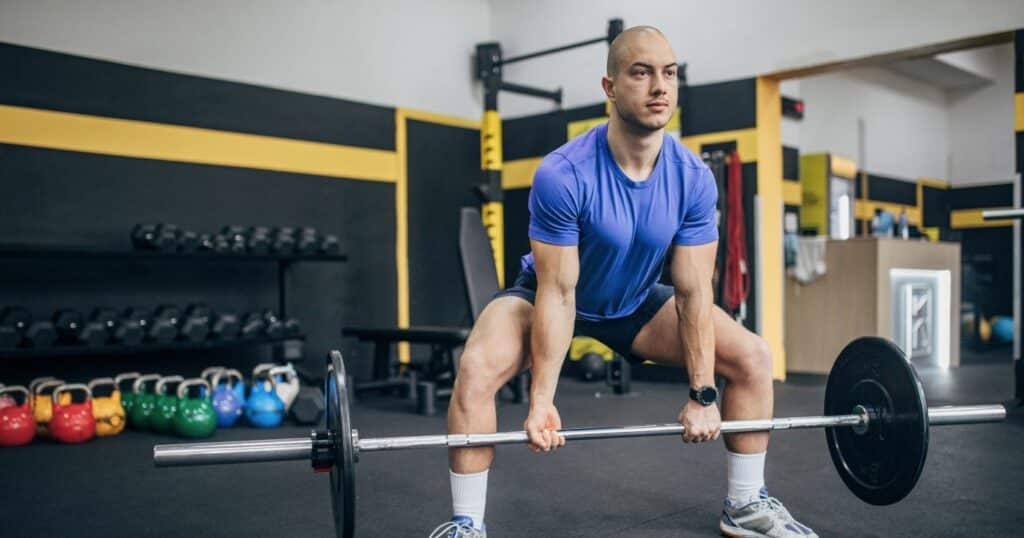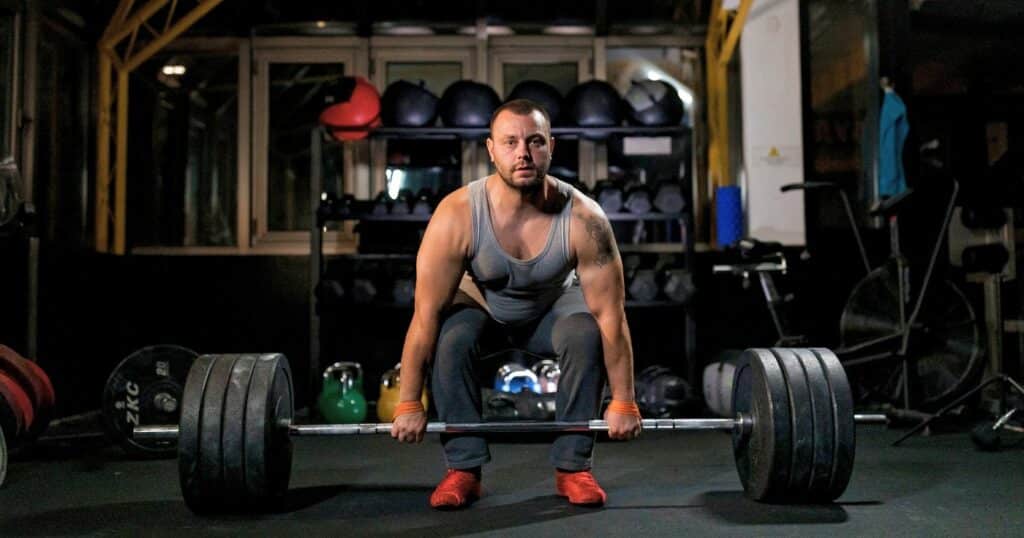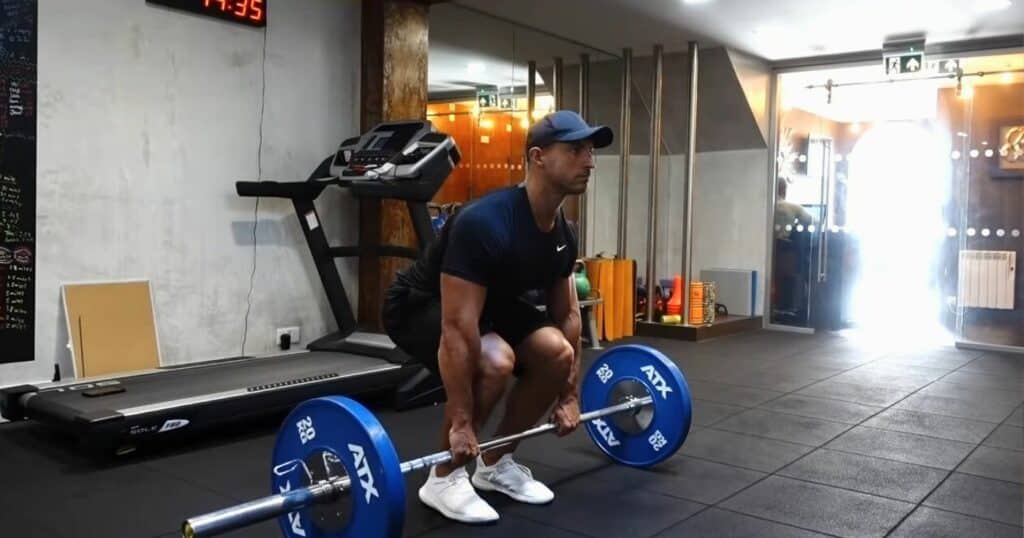Most lifters love deadlifts.
But I hear this question all the time: Which variant is best, the sumo or the conventional deadlift?
This debate not only touches on personal preference but delves into the nuances of biomechanics and targeted muscle activation.
In this article, you will learn:
- The distinctive technical and postural differences between sumo and conventional deadlifts.
- The advantages and potential limitations of each technique.
- Guidance on selecting the deadlift style that aligns with your unique physique and training objectives.
Jump to:
Key Differences Between Sumo and Conventional Deadlifts
Each technique has its unique stance, grip, and muscle emphasis, making them suitable for different types of lifters.
Sumo Deadlift:

- Technique and Stance: The sumo deadlift is characterized by a wide stance with feet significantly beyond shoulder-width apart, toes pointed outward. The hands grip the bar inside the legs, closer together than in the conventional deadlift. This positioning allows for a more upright torso during the lift.
- Muscle Emphasis: This variation places greater emphasis on the quadriceps, glutes, and adductor muscles of the inner thigh. The wide stance and upright posture reduce the strain on the lower back, shifting the workload to the legs and hips (Escamilla et al., 2000).
Conventional Deadlift:

- Technique and Stance: In contrast, the conventional deadlift features a narrower stance, with feet about hip-width apart. The hands grip the bar outside the legs, creating a need to hinge more at the hips and bend further forward. This form demands significant engagement from the lower back, hamstrings, and erector spinae.
- Muscle Emphasis: The conventional stance is particularly effective at targeting the posterior chain, including the hamstrings, glutes, and entire back. This style is often recommended for developing back strength and overall posterior muscle mass (Escamilla et al., 2000).
Comparison:
- The sumo deadlift often allows for a heavier lift due to the reduced range of motion and more significant leg involvement. It’s particularly favored by those with a stronger lower body or those seeking to minimize lower back stress.
- The conventional deadlift, with its greater emphasis on the posterior chain, is ideal for those looking to strengthen these areas specifically. It’s also considered more of a ‘pure’ hinge movement, closely mimicking everyday lifting mechanics.
Pros and Cons of Sumo Deadlift

Advantages of Sumo Deadlift:
- Reduced Lumbar Strain: Due to the upright torso position, the sumo deadlift typically exerts less pressure on the lower back compared to its conventional counterpart. This can be particularly beneficial for those with a history of back issues or those looking to minimize lower back engagement.
- Greater Leg Involvement: The wide stance increases the activation of the quadriceps and adductors, making it an excellent choice for individuals aiming to strengthen these areas.
- Shorter Range of Motion: The sumo deadlift generally involves a shorter bar path, which can allow for lifting heavier weights. This characteristic is advantageous in powerlifting competitions and for those focused on maximizing their lifting efficiency.
Potential Drawbacks:
- Mobility Requirements: The sumo stance demands good hip, groin, and overall leg flexibility. Lifters with limited mobility may find it challenging to adopt or maintain the proper sumo posture.
- Specific Strength Development: While the sumo deadlift effectively targets certain muscle groups, it may not provide as comprehensive a posterior chain workout as the conventional deadlift. This could be a consideration for those prioritizing overall back and hamstring development.
Pros and Cons of Conventional Deadlift

Advantages of Conventional Deadlift:
- Comprehensive Posterior Chain Engagement: This variation excels in targeting the entire back, hamstrings, and glutes, contributing to a well-rounded development of the posterior chain.
- Lower Body Flexibility: With less demand for extreme leg spread, the conventional deadlift can be more accessible for individuals with limited flexibility.
- Functional Movement Pattern: The mechanics of the conventional deadlift closely mimic real-life lifting scenarios, potentially offering more practical strength benefits.
Potential Drawbacks:
- Increased Lower Back Stress: The forward lean and hip hinge required in the conventional deadlift put significant strain on the lower back. This might raise concerns for individuals prone to lumbar discomfort or injury.
- Longer Range of Motion: The increased distance the bar must travel can make lifting heavier weights more challenging compared to the sumo deadlift, potentially affecting overall lifting efficiency for some athletes.
In “Why (Almost) Nobody Should Pull Sumo,” Kyle Mask articulates a robust defense of the conventional deadlift over the sumo variant, especially for those not hindered by physical limitations. Here’s a distilled summary of his key arguments:
- Misinformation and Choice: Mask challenges the prevalent notion that sumo deadlifts are inherently superior, pointing out a lack of critical analysis in favor of the conventional method for most lifters.
- Mechanical Efficiency: He argues that conventional deadlifts demand more from both the back and hips, contrary to the popular belief that sumo deadlifts provide a harder hip workout.
- Physiological Benefits: By engaging more muscle mass through a longer range of motion, conventional deadlifts offer superior strength development and muscle engagement, including better activation of the hamstrings.
- Training Philosophy: Mask suggests that even for those competing in sumo, incorporating conventional deadlifts can enhance back and hip strength, advocating for a training regimen that prioritizes overall strength and muscle development over lifting heavier weights through reduced movement.
Mask’s perspective underscores a preference for conventional deadlifts based on biomechanical analysis and training efficacy, advocating for a focus on building strength comprehensively.
How to Choose the Right Deadlift Style for You
Here are factors to consider and steps to take when deciding which deadlift style aligns best with your physique, flexibility, and strength training goals.
1. Assess Your Body Type:
- Limb Length: Individuals with longer arms relative to their torso may find the conventional deadlift more natural, as it allows them to reach the bar without excessively bending over. Conversely, those with a shorter arm span might prefer the sumo deadlift, as the wider stance reduces the distance between their hands and the bar.
- Longer torsos: Performers with longer torsos relative to their total height might find the sumo deadlift slightly more mechanically advantageous, while those with shorter torsos may benefit more from the conventional style. This highlights the importance of considering individual differences in body proportions when choosing between deadlift styles (Cholewa et al., 2019).
- Hip Mobility: High hip mobility can make the sumo stance more comfortable and effective. If you have tight hips or limited groin flexibility, starting with the conventional deadlift and working on your mobility might be advisable.
2. Consider Your Strengths and Weaknesses:
- If your quadriceps are strong and your lower back is a weaker link, the sumo deadlift can leverage your strengths while minimizing stress on your lower back.
- For those with a strong back and hamstrings, the conventional deadlift might offer the best chance to utilize and further develop these areas.
3. Experiment and Evaluate:
- Safety First: Regardless of which style you’re experimenting with, ensure you’re performing the lift with proper form to minimize injury risk. Consulting with a strength and conditioning coach can provide valuable feedback.
- Trial Period: Give yourself several weeks to try out each style. Some lifters may find immediate preferences, while others need time to adapt and evaluate how each form affects their body and lifting goals.
- Monitor Your Progress and Comfort: Pay attention to how each style influences your lifting performance, any pain or discomfort experienced, and overall progress towards your strength goals.
4. Flexibility and Injury Prevention:
- Incorporate mobility work into your routine to enhance your ability to perform both styles effectively. A flexible, well-prepared body is less prone to injury and better equipped to handle various lifting demands.
5. Listen to Your Body:
- Ultimately, the right choice is the one that feels best for your body and aligns with your lifting objectives. If one style consistently causes discomfort or doesn’t contribute to your progress, it may not be the right fit for you.
Greg Nuckols, in his comprehensive article “Should you Deadlift Conventional or Sumo?”, delves into the nuances of this debate, providing clarity based on biomechanics and personal strengths rather than generic measurements. Here’s a distilled overview focusing on the core insights:
Understanding Hip Structure’s Role
- Biomechanics Over General Measurements: Nuckols argues that the choice between sumo and conventional deadlifts hinges on individual hip structure more than height, limb lengths, or other general body measurements.
- Determinants of Hip Motion and Strength: The shape of the pelvis, location and depth of the hip sockets, femur angles, and rotation capabilities are critical. These factors significantly influence one’s range of motion and capacity to develop muscular tension in either deadlift style.
Dispelling Common Misconceptions
- Range of Motion: Although sumo deadlifts have a shorter range of motion, this does not inherently make them easier. The brief duration of maximum effort lifts means that performance isn’t limited by the range of motion.
- Hip Extension Torque: Contrary to popular belief, the hip extension demands are nearly identical in both styles. This is due to hip extension occurring in three dimensions, thus similarly affecting biomechanics.
Practical Advice for Style Selection
- Empirical Approach: Nuckols recommends training in both styles for several months. The choice should be based on which style feels stronger and more comfortable with submaximal loads. Addressing specific weaknesses is crucial if one style feels better but performs worse.
- Key Differences:
- Quad Demand: Sumo deadlifts place more demand on the quadriceps.
- Back Demand: Conventional deadlifts exert more demand on the spinal erectors, especially off the floor.
Lifter Preferences and Performance
- Influence of Body Type and Strength: Lighter and female lifters often prefer sumo, possibly due to relative back or torso strength. The preference between sumo and conventional can also reflect one’s training background and the relative strength of different muscle groups.
Conclusion
- Sumo deadlifts, with their wide stance and reduced lumbar strain, cater to those seeking to leverage their quad strength and minimize back stress.
- Conventional deadlifts shine in their ability to comprehensively target the posterior chain, benefiting those with a focus on back and hamstring development.
- Deciding which style to adopt involves considering your body type, mobility, and training goals, alongside a willingness to experiment and listen to your body’s feedback.
References:
- Cholewa, Jason M et al. “Anthropometrical Determinants of Deadlift Variant Performance.” Journal of sports science & medicine vol. 18,3 448-453. 1 Aug. 2019
- ESCAMILLA, RAFAEL F.; FRANCISCO, ANTHONY C.; FLEISIG, GLENN S.; BARRENTINE, STEVEN W.; WELCH, CHRISTIAN M.; KAYES, ANDREW V.; SPEER, KEVIN P.; ANDREWS, JAMES R.. A three-dimensional biomechanical analysis of sumo and conventional style deadlifts. Medicine & Science in Sports & Exercise 32(7):p 1265-1275, July 2000.















